Walking Tour Locations nearby Us
Chinese Fishing Nets / Vasco da Gama Square
These huge cantilevered fishing nets are the legacy from the ancient visitors to the Malabar coast. Built in the 14th century AD by traders from the court of Kublai Khan, these ingenious contraptions were made from locally available teak wood and bamboo poles. The best place to watch the nets being lowered into the sea and raised with the catch is the Vasco da Gama Square, a paved promenade that runs along the beach. The Square is an ideal place to idle away time, or enjoy delicious seafood or tender coconut from the nearly stalls.
Pierce Leslie Bungalow 
This charming mansion used to be the busy office of M/s. Pierce Leslie & Co. Who traded in coffee and other produce from Kerala from the year 1862 onwards till recently. A prominent colonial bungalow in Fort Cochin, it combines Portuguese, Dutch and also local style of architecture. Characteristic features are wooden panels that for a false ceiling to the ground floor halls, arched doorways, carved doors and sprawling rooms. Waterfront verandahs add to the glamour of the edifice.
Old Harbor House
This elegant old bungalow, built in 1808 belonged to Carrit Moran & Co., renowned tea brokers. Now they have converted the bungalow into a hotel. For an interim period it was also used as a club house.
Maritime Museum – I N S Dronacharya, Fort Kochi
The Museum is housed in two magazines operated by the British during the World War-II. It is located on the Beach Road, approximately 1 km south of St. Francis Church in Fort Kochi.
The Museum showcases the rich maritime heritage of India. A sound & light show depicting the Indian Navy in Action from 1946 up till the Kargil conflict between India and Pakistan is available for viewing. On display are various vintage weapons, equipments and missiles.
Time: 09:30 AM - 1:00 PM/
02:00 PM - 6:00 PM /
(Monday Holiday).
Koder House
This magnificent building constructed by Samuel S. Koder of The Cochin Electrical Company in 1808 is a supreme example of the transition from colonial to Indo European architecture. Features like verandah seats at the entrance, floor tiles set in a chess board pattern, red colored brick like façade, carved wood furniture and a wooden bridge connecting to a separate structure across the street are all unique to this bungalow.
Delta Study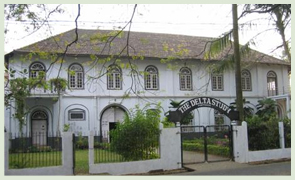
Built in 1808, this structure became part of the properties of Volkart, formerly a famous Swiss commodity trading house. A fine example of a heritage building, it now functions as a school building.
Santa Cruz Basilica
This famous church was built by the Portugese and later elevated to a cathedral in 1558 by Pope Paul IV. But it was demolished in 1795 during the British rule of Fort Kochi. In 1887 Bishop Dom Gomez Fereira authorized the re-building of the cathedral and consecrated the new edifice in 1905. Santa Cruz was proclaimed a basilica in 1984.
Loafers’ Corner/ Princess Street
A traditional hangout frequented by the youth in the neighborhood, the building still retains some of its old charm of the European style of construction.
Vasco House
Built in the first half of the 16th century, Vasco House is one of the oldest Portuguese houses and stands at a corner on the Rose Street. It is believed that Vasco da Gama had resided in this sprawling house and hence its name.
VOC Gate
Facing the Parade ground is a large gate with the initials VOC. The monogram, which is dated 1740, represents the once mighty Dutch East India Company, which had its offices here for almost 150 years. Contrasting the past the gate leads to cinnamon, today one of India’s hippest design stores and Malabar escapes I trinity a three suite ‘contemporary design insert’ showcasing the best of up-to-date Indian design & art in dialogue with well-positioned old furniture and art objects.
Parade Ground
Surrounded by impressive century old trees, the Parade Ground was used by the Portuguese, the Dutch and the British to conduct military drills and parades. It is situated in the heart of Fort Kochi and you can see some of the fine old buildings surrounding it. These buildings accommodated the administration of the colonial powers. Today it is the largest open space in Fort Cochin and serves as a public sports ground for football & cricket. The Malabar House (picture above) faces Parade Ground.
Jewish Synagogue – Mattancherry

Built in 1568 AD. This building houses some ancient articles like the Great Scrolls of the Old Testament, the copper plates with royal inscriptions issued to the colonists by the ruling Maharaja of Cochin State, and the exquisite Chinese hand-painter tiles.
Open: 10:00AM – 12:00PM and 15:00PM – 17:00PM.
Closed on Saturdays and Jewish Holidays.
Mattancherry Palace (Dutch Palace)

Built by the Portuguese and presented to the Raja (King) of Cochin in 1557 AD, it acquired the present name after 1663 when the Dutch carried out extension and renovation in the Palace. Its interiors are decorated with murals from the epic Ramayana. Also there are exhibits of some royal costumes and palanquins used by the Rajas for travel.
Open: 10:00AM – 17:00PM.
Closed on Fridays and National Holidays.
United Club
This is one of the four clubs of the British Period registered with the authorities in Fort Cochin. It was in this building that the offices of the Fort Cochin Municipality functioned till 1907.
Indo-Portuguese Museum / Bishop’s House
Standing on a gentle hillock near the Parade Ground, the Bishop’s House boasts a facade having large gothic arches. Originally build in 1506 AD for the residence of the Portuguese Governor; it was the turn of the Dutch to occupy it from 1663 AD. After the British conquest in 1795 the property came into the possession of the Vernedes family. From them it moved into the hands of Dom Jose Gomes Ferreira, the 27th Bishop of Cochin, whose jurisdiction extended over to Burma, Malaya and Ceylon, in addition to the whole of Southern and Eastern India.
Today, a Museum depicting Indo-Portuguese history is functioning in a newly built hall. A visit to this history – laden museum is highly recommended.
Incidentally, the Cochin Heritage Home is situated just opposite to this Bishops House (Indo-Portuguese Museum).
The Dutch Cemetery
Consecrated in 1724, the cemetery now belongs to the Church of South India. The faded inscriptions on the tombstones are the most authentic reminders and records of the countless men and women who left Europe to play their roles on the colonial canvas of the 17th, 18th and 19th century Fort Cochin.
Thakur House
This magnificent bungalow was built on the sea side, facing Gelderland Bastion, one of the seven bastions of the Dutch Fort. Its graceful lines reflect the leisurely lifestyle of the colonial era. Now owned by the known tea trading company Ram Bahadur Thakur. It was earlier known as Hill bungalow.
David Hall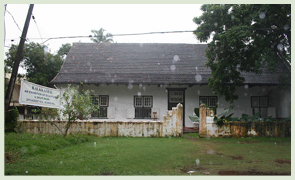
Built in 1695 by the Dutch East India Company, the house is associate with Hendrik Adrain van Rheede, the Dutch Governor of Malabar. Today this gentleman is better remembered for his outstanding contribution to botany compiling “Hortus Malabaricus” about the flora of the Malabar Coast in Kerala. The current name is derived from a member Jewish community. The present owners, the Foundation of the cultural history of the Netherlands Overseas (CNO) India, are planning an extensive renovation in the near future.
Cochin Club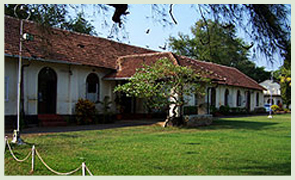
The Club buildings with its old world charm dates back to the early 20th century. Standing in a beautiful park, it was a typical British club till Indian Independence, restricted to male membership only. Times have changed, but the present 350 members keep the place with its history alive and ticking.
St. Francis Church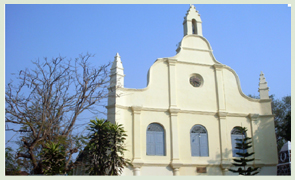
Considered as India’s oldest European Church, it was originally Roman Catholic Church during the Portuguese period from 1503 till 1663 Ad, then Dutch Reformist till 1804, and Anglican till 1947. Today it is part of the Church of South India. The Original timber structure was demolished and reconstructed using stone masonry during the 16th century. Vasco da Gama who died in Cochin in 1524 was buried here but 14 years later his remains were exhumed and taken to Portugal 14.
Bastion Bungalow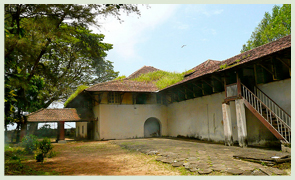
Located on the site of the Stromberg Bastion of the Old Dutch fort and over looking the harbor entrance, the bungalow merges picture perfect into the circular structure of the old bastion. Planned in 1667, it is Indo-European in style with the typical large first floor verandah and tiled roof. Though there are innumerable tales of secret tunnels below the house, none has ever been found.
Fort Immanuel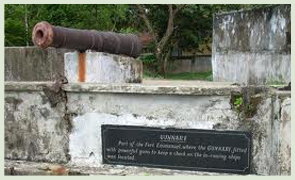
Built in 1503, Fort Immanuel was a symbol of the strategic alliance between the Rajah of Cochin and Monarch of Portugal, after whom it was named. The Fort was strengthened in 1538, but after the Dutch conquest in 1663 it deteriorated to a third of its original size. In 1806 the British brought down the huge walls of the Fort and most of the bastions. Now its remains can still be traced along the beach, some under water.








 The Museum is housed in two magazines operated by the British during the World War-II. It is located on the Beach Road, approximately 1 km south of St. Francis Church in Fort Kochi.
The Museum is housed in two magazines operated by the British during the World War-II. It is located on the Beach Road, approximately 1 km south of St. Francis Church in Fort Kochi.







 Built by the Portuguese and presented to the Raja (King) of Cochin in 1557 AD, it acquired the present name after 1663 when the Dutch carried out extension and renovation in the Palace. Its interiors are decorated with murals from the epic Ramayana. Also there are exhibits of some royal costumes and palanquins used by the Rajas for travel.
Built by the Portuguese and presented to the Raja (King) of Cochin in 1557 AD, it acquired the present name after 1663 when the Dutch carried out extension and renovation in the Palace. Its interiors are decorated with murals from the epic Ramayana. Also there are exhibits of some royal costumes and palanquins used by the Rajas for travel.






 Built in 1503, Fort Immanuel was a symbol of the strategic alliance between the Rajah of Cochin and Monarch of Portugal, after whom it was named. The Fort was strengthened in 1538, but after the Dutch conquest in 1663 it deteriorated to a third of its original size. In 1806 the British brought down the huge walls of the Fort and most of the bastions. Now its remains can still be traced along the beach, some under water.
Built in 1503, Fort Immanuel was a symbol of the strategic alliance between the Rajah of Cochin and Monarch of Portugal, after whom it was named. The Fort was strengthened in 1538, but after the Dutch conquest in 1663 it deteriorated to a third of its original size. In 1806 the British brought down the huge walls of the Fort and most of the bastions. Now its remains can still be traced along the beach, some under water.

